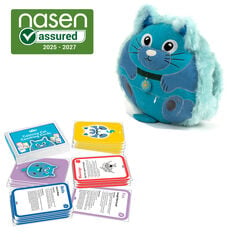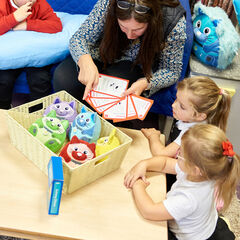Calming Cat
If you have not met this resource before, let me introduce you to Calming Cat (although it will forever be Cuddle Cat to me). Even though I appreciate a good stuffed animal, what is it that really sets Calming Cat apart? It is the theoretical and psychological considerations that went into its development. Not only is there a weighted cuddly toy, but there is a set of advice cards designed to support its use. From cards explaining how the pack works to those which offer activities and guidance for its use.

Why a cuddly toy?
Cuddly toys, also known as stuffed animals or plushies, can be comforting and soothing for children. Especially when they are feeling overwhelmed or distressed. They can provide a sense of security and familiarity and can be used as a tool for self-regulation.
Emotional Benefits
For children who are dysregulated, cuddly toys can be especially helpful in helping them manage their emotions and behaviours. These toys can provide a sense of comfort and support. They can help children feel more in control of their emotions and behaviours. Cuddly toys can also be a helpful distraction during times of stress or anxiety. They provide a way for children to focus their attention on something other than their negative emotions.
Physical Benefits
In addition to the emotional benefits, cuddly toys can also have physical benefits for children. For example, hugging a cuddly toy can help to release oxytocin. This is a hormone that is associated with feelings of love, bonding, and relaxation. It can help children feel calmer and more relaxed, which can in turn, improves their overall well-being.
A cuddly toy can potentially help regulate the Autonomic Nervous System (ANS) by activating the “social engagement” mode. When an individual holds or cuddles a cuddly toy, it can stimulate the Parasympathetic Nervous System (PNS). This is associated with feelings of calm and connection. This can help to slow down the heart rate and regulate the ANS, promoting a sense of relaxation and well-being.
In addition, cuddly toys can provide a sense of comfort and familiarity, which can help to reduce stress and anxiety. By providing a source of comfort and support, cuddly toys can help individuals feel more secure.
Strategy Cards
The cards in the pack explain in more detail about how we are essentially a ‘bag of chemicals’. Paula Williams, the Educational Psychologist who designed the set, is clear to point out we shouldn’t be afraid to use the correct language with children. The cards are simple to understand. They provide the Calming Cat Coach (adult) with the language, theory and practice they need in order for Calming Cat to extend beyond its initial appearance as a cuddly toy.

Polyvagal Theory
The Polyvagal Theory has been used to underpin the development of the activities.
According to Polyvagal Theory, the autonomic nervous system (ANS) plays a key role in regulating emotions and behaviours. Dysregulation, or difficulty managing and controlling emotions, behaviours, and physiological states, can be related to dysfunctions or imbalances in the ANS.
Polyvagal theory proposes that there are three different modes of operation of the Autonomic Nervous System (ANS): the “survival” mode, the “social engagement” mode, and the “immobilisation” mode. When the ANS is functioning optimally, it can shift between these different modes in response to different situations and needs. However, suppose there is a dysfunction or imbalance in the ANS. In that case, it may be more difficult for an individual to shift between these modes, leading to difficulty regulating emotions and behaviours.
For example, if an individual is stuck in the “survival” mode, they may be more reactive to stress and more prone to outbursts of anger or frustration. If they are stuck in the “immobilization” mode, they may have difficulty engaging with others and may be more prone to withdrawal or dissociation.
Polyvagal theory provides a framework for understanding how dysregulation can be related to ANS functioning and can inform interventions and treatments for individuals with dysregulation.
PORGES, S.W. (1995) ‘Orienting in a defensive world: Mammalian modifications of our evolutionary heritage. A Polyvagal Theory’, Psychophysiology. Received March 6, 1995; Accepted March 23, 1995, 32(4), pp. 301–318. Available at: //doi.org/10.1111/j.1469-8986.1995.tb01213.x.
Calming Cat Activities
Each activity within the pack is built on the movement from a state of dysregulation to one of stability and regulation.
For example, focussing on just one of the key features of the pack, let’s look at controlled breathing.

What is controlled breathing?
Controlled breathing is a relaxation technique that involves focusing on and intentionally controlling the breath in order to achieve a state of calm and relaxation. Controlled breathing involves taking slow, deep breaths and exhaling slowly, with the aim of slowing down the heart rate and calming the mind and body.
It is often used as a relaxation technique to reduce stress, anxiety, and other negative emotions and can be practised anywhere and at any time. It is a simple and effective way to promote relaxation and well-being.
In the pack, there are multiple cards offering different ways to approach controlled breathing: Nostril breathing, Lion’s breathing, Elbow breathing, Colour breathing, Blow football, Octopus breathing and others.
In conclusion:
Calming Cat has now got some Calming Kittens which are suitable for younger children. Click this button to find out more.I love Calming Cat (Cuddle Cat), and the pack of materials makes it more than just a cuddly toy in the classroom; it provides a true well-being and self-regulation resource for students and a supportive framework for intervention with integrity for the staff involved. It gets a 5/5 from me!
Abigail Hawkins, SENsible SENCO
Thank you to Abigail Hawkins, SENsible SENCO for sharing this review with us.
Abigail is a highly experienced award winning SEN Consultant, Educator, Advocate, Keynote Speaker, Author, and SENCO Support Network Founder





